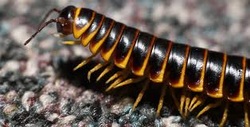Millipede Collection
Millipedes are one of the most diverse (experts estimate of up to 80,000 species globally) and understudied (~12,000 species described) groups of arthropods. Many species are short-range endemics. Millipedes can serve an important role in many ecological processes such as decomposition and carbon cycling. Like many other organisms, millipede diversity in many parts of the world is threatened by land-use change, urbanization, and invasive species. Documenting biodiversity and biogeography is a critical first step to conservation of these species and other soil organisms. This project will contribute to research in millipede biodiversity and conservation by documenting millipede diversity in places which may be difficult to access and/or where few millipede taxonomists are working.
How can volunteers participate?
Millipedes are found in leaf litter and soil in many habitats as long as there is moisture and organic matter present. Volunteers for this project would search for millipedes in appropriate habitats. Millipedes are not venomous and do not sting or bite, and they are safe to collect by hand. These would be collected and killed/preserved in ethanol. Volunteers would collect data on the collection location to include with each set of specimens.
How will this data be used?
Millipede specimens will be identified to species. Undescribed species are highly likely and these will be described and published in the peer-reviewed literature. Publications describing new distribution records will also be produced.

